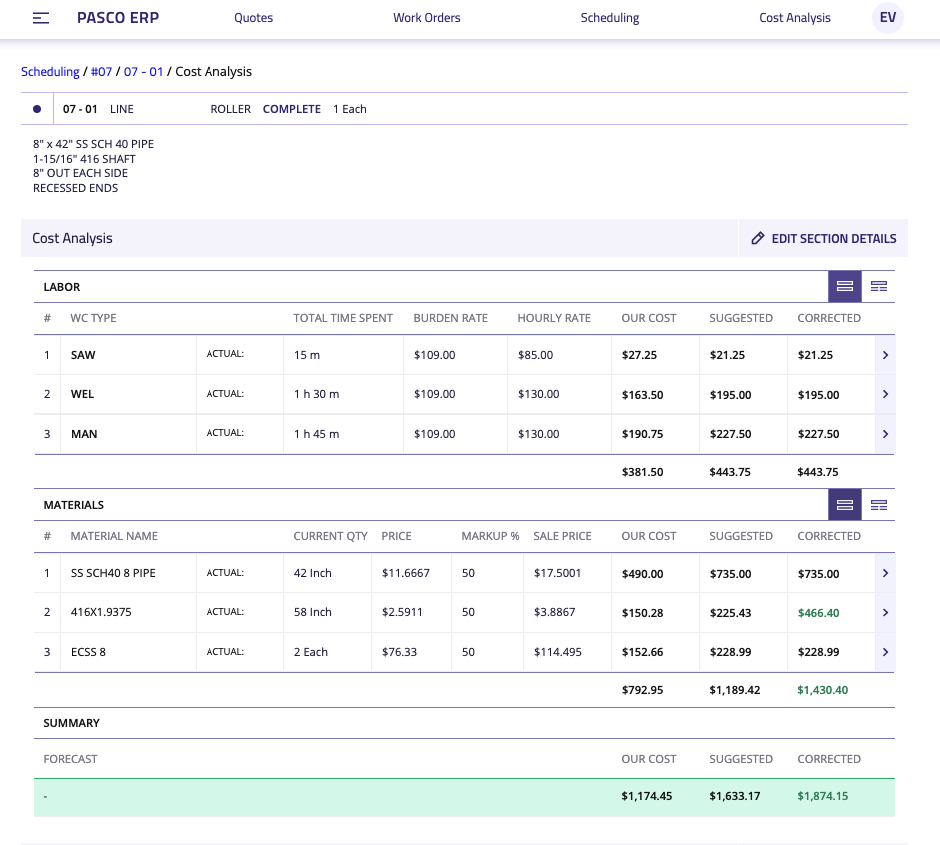WEB APP
Pasco Machine
A highly usable, custom ERP streamlined for this shop’s unique business needs.
Back End Development / Dev Ops / Digital Product Strategy / Enterprise System Development / Front End Development / UX/UI Design / Web Application Development

After the Pasco team enthusiastically embraced the digital scheduling software we designed and deployed in 2019, they turned their sights to their ERP. Pasco had been using an enterprise off-the-shelf solution for the past five years. It worked…fine. And there were even some nice wins simply by getting out of pen-and-paper. But there was a lot that could be better.
THE Goal
An ERP designed to do exactly what Pasco needs — no less, but also no more.
No one was mistaken that Pasco’s existing ERP was designed for them. As Eugene, our product director, put it, they were using 5% of the system for their day-to-day operations, but had to keep up the other 95% just to pull an accurate report. We wanted the exact opposite: a nimble, requirements-based product that did everything it needed to do, and no bloat from nice-to-haves.
Plus, the customer support from the off-the-shelf provider wasn’t sustainable. Requested changes would take weeks or months to push through — not uncommon when you’re one of many enterprise clients, but obviously not ideal.
We set out on the same partnership approach we’d used on their scheduling software: building trust by learning the why and who before deciding on the what and how. And just like before, it paid off.
“FORCED” OPERATIONS
The best way for us to build something as complex as an ERP from scratch is to ask, “Why?” A lot. Over five years, a lot of Pasco’s operations had developed to accommodate their old ERP, even if they weren’t necessary for the business.
Take reporting, for example. Pasco’s existing ERP couldn’t produce any real-time reporting within the platform — the only option was to export as a PDF. Pasco was up to their elbows in PDFs, and all their corresponding needs: email attachments, a central place to save and store, access control, naming conventions. This is all “process” and something we wanted to be really thoughtful about in our new, streamlined version.
We knew real-time reporting right in the platform would solve a lot of these issues. But we also know that changing process on a dime isn’t always easy. We maintained export functionality in the dashboard — but ideally, Pasco will be less and less dependent on PDFs over time.
Some major operational changes the team can’t wait to execute — like integrated electronic time tracking. It was a long-desired functionality that erased $30,000+ annually in paper time cards, and opened up bandwidth for one full-time accountant who had been spending a substantial portion of their time inputting analog time cards into their existing ERP.
THE RIGHT EXPERIENCE

Whenever it’s possible, we like to work alongside the do-ers. They’re who can teach us the actual processes we’re building — and who can provide the most insight when we ask, “Why?”
A good example is Pasco’s work order flow. The more members of the team we spoke with, the more we realized that the existing flow was overwhelming. It became obvious why so much information on each work order was often left blank.
So instead of one long form, we split it into multiple screens with a specific focus: customer information, product specifications, unique work centers, purchase requests, generating quotes. We added a wizard to carry users through each step. We included the ability to stop and save drafts, and come back later to add more information. The final result was a work order flow the Pasco team hadn’t realized could be achieved.
Killing OUR DARLING

We don’t always get it right on our first try. We had to significantly revise the work order flow three times as more users experimented with MVP versions and provided feedback. And as we got ready to incorporate our original scheduling calendar into the new ERP, we learned more again.
After having used the calendar for a year, we found out that about 70% of the data visualization we had built in was generally ignored in favor of a more concise one-day planning view. Goodbye, Gannt chart. Hello pre-filtered table.
TWO-WAY SYNC WITH QUICKBOOKS

Pasco uses on-premise Quickbooks, which doesn’t integrate easily with third-party systems like our ERP. The accounting team gave the web version of Quickbooks a try, but it didn’t gel — and so we needed a way to get data flowing between the two systems.
This is where working with a boutique dev shop like Bilberrry can really pay off. We were as dedicated to an ideal ERP as Pasco was, so building a custom middleware to allow two-way syncing between our platform and Quickbooks became part of the roadmap.
Now the ERP can pull cost analysis reports that include all job costs in granular detail, with the ability to marke correction and impact overall invoiced amounts. The accounting team has seamless access to work orders, customer info, and employee time sheets so they can send invoices, pay bills, and do payroll. It’s a huge win for everyone.

